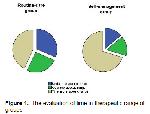In this single-center, retrospective study, we conducted a comprehensive search from January 1, 2016 to December 31, 2017 for patients using warfarin for any reason and attending routine INR monitoring. Demographic and clinical data including age, sex, medical history (the presence of hypertension, diabetes mellitus, hyperlipidemia, congestive heart failure, coronary artery disease, chronic renal failure, end-stage renal disease, cerebrovascular disease, pulmonary embolism, and deep venous thrombosis), smoking status were recorded (Table
1). Additionally, CHA2DS2-VASc (Congestive heart failure, Hypertension, Age [≥65 = 1 point, ≥75 = 2 points], Diabetes, and Stroke/TIA [2 points], vascular disease [peripheral arterial disease, previous miyocardial infarction, aortic atheroma] and female gender) (cutoff ≥2), and HAS-BLED (hypertension, abnormal renal/liver function, stroke, bleeding history or predisposition, labile international normalized ratio, elderly [>65 years], drugs/alcohol concomitantly) (cutoff ≥3) were calculated using these data. The sample size was estimated based on the probable number of participants that could be recruited in a reasonable time with a 3:1 allocation ratio. A calculation of sample size revealed that at least 233 patients for all groups were needed to detect differences between results with a statistical power (1-β value) of 95% allowing for a type i (α) error of 0.05. Of those 233 patients, 175 should be placed in the the routine care group and 58 should be placed in the self-management group with an actual power. A total of 237 patients were selected in the current study. Patients were divided into two groups: The routine care group consisted of 179 subjects (75 men, with a median of 61 (51 to 68) years), and the self-management group included of 58 age and sex-matched individuals (26 men, with a median of 64 (56 to 70) years).
In the self-management group, patients INR results gathered from the CoaguChek XS (Roche Diagnostics, Basel, Switzerland) which is a whole blood sampling point-of-care testing (POCT) device using strips containing a human thromboplastin (ISI=1). In the routine care group, patients INR results gathered from Stago Star Evolution (electromechanical cloth detection after addition of a rabbit brain thromboplastin-STA Neoplastin) in the central lab at hospital or at an anticoagulation clinic. Self-management group received a structured educational series given by the nurse or physician responsible for care. Also, they received training in self-testing with the portable device, instructions to prevent bleeding or thromboembolic complications and were educated diet and medication.
Patients were excluded if anticoagulant treatment had been interrupted during these 12 months or if the patients had a severe psychiatric disease or terminal illness. Patients were informed by their physician of their individually defined INR therapeutic target ranges. Informed consent was obtained from the control group involved in this study. The study was approved by the Institutional Ethics Committee.
If the patients had more than one indication of anticoagulation treatment with warfarin, the main reason was selected as the primary warfarin indication. TTR was calculated according to F.R. Roosendaals algorithm with linear interpolation (2). An interpolated INR value was assigned to each follow-up day. TTR was the mean percentage of days that the INR for an individual patient as in the therapeutic range of 2.03.0 or 2.53.5.
The target of INR was 2.5 (range 2.03.0) in patients with a mechanical aortic valve, non-valvular AF, and the other reasons. The target of INR was 3 (range 2.53.5) in patients with a mechanical mitral valve and mechanical heart valves in both the aortic and mitral position (9). We recorded the patients mean warfarin dosages as ≤2.5 mg, 2.55 mg, 510 mg, or ≥10 mg daily and we also calculated the proportion of time below the therapeutic INR range, proportion of time above the therapeutic range.
Major bleeding was defined as a reduction in the hemoglobin level of at least 20 g/L or requiring transfusion of at least 2 units packed blood cells, or hemorrhage into a critical anatomical site (e.g. intracranial, retroperitoneal, intracranial, intraspinal, intraocular, retroperitoneal, intra-articular or pericardial, or intramuscular with compartment syndrome) (10). Minor bleeding was defined any non-major bleeding. Thromboembolic events were stroke, arterial embolism, symptomatic deep-vein thrombosis, or pulmonary embolism (11).
Statistical analyses were performed using SPSS software version 22 (SPSS Inc. Chicago, IL, USA). The variables were investigated using visual (histograms, probability plots) and analytical methods (Kolmogorov Smirnov/Shapiro-Wilk test) to determine whether or not they are normally distributed. Continuous variables were presented as a mean ± SD or medians (interquartile ranges), whereas categorical variables were summarized as the number of cases with the percentage (%). Overall comparisons of categorical variables were performed using Pearsons χ2 test and Fishers exact test. Student t-test was used for normally distributed parameters, whereas Mann Whitney U test was used for the parameters not distributed normally. The study population was also divided into two groups: Poor control and good control group. The cut-off point for TTR 55% (defined by Nelson et al. (12) and Baker et al. (13) was used for the discrimination of the groups.
Logistic regression was used to determine which variables were associated with poor control. Candidate variables were those that showed significance in the bivariate analysis or those that had been reported to show an association with control of INR in previous studies: sex, age, hypertension, type 2 diabetes mellitus, renal failure, CHA2DS2-VASc, HAS-BLED, and staff charged with validating the INR (routine care or self-management strategy). Hosmer-Lemeshow goodness of fit statistics was used to assess model fit. In the graphical representation of pie charts were used. A p value less than 0.05 was considered statistically significant.





